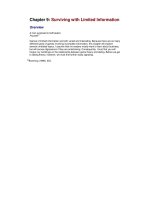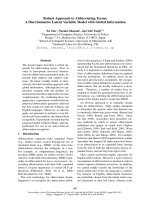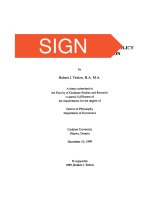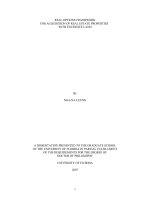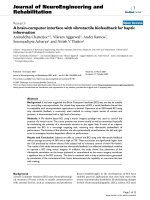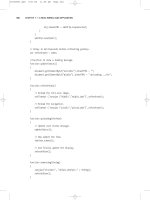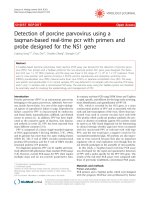Resolving a Real Options Paradox with Incomplete Information After All, Why Learn
Bạn đang xem bản rút gọn của tài liệu. Xem và tải ngay bản đầy đủ của tài liệu tại đây (180.95 KB, 27 trang )
Resolving a Real Options Paradox with Incomplete Information: After All, Why Learn?
Spiros H. Martzoukos and Lenos Trigeorgis
Department of Public and Business Administration
University of Cyprus - Nicosia
September 2000, this version March 2001
JEL classification: G31; G13
Keywords: Real Options, Incomplete Information and Learning, Asset Pricing
Address correspondence:
Spiros H. Martzoukos, Assistant Professor
Department of Public and Business Administration, University of Cyprus
P.O.Box 20537, CY 1678 Nicosia, CYPRUS. Tel.: 357-2-892474, Fax: 357-2-892460.
Email:
Resolving a Real Options Paradox with Incomplete Information: After All, Why Learn?
Abstract
In this paper we discuss a real options paradox of managerial intervention directed towards
learning and information acquisition: since options are in general increasing functions of
volatility whereas learning reduces uncertainty, why would we want to learn? Examining real
options with (costly) learning and path-dependency, we show that conditioning of information
and optimal timing of learning leads to superior decision-making and enhances real option
value.
2
Introduction
Most of the real options literature (see Dixit and Pindyck, 1994, and Trigeorgis, 1996)
has examined the value of flexibility in investment and operating decisions, but little has been
written about management´s ability to intervene in order to change strategy or acquire
information (learn). Majd and Pindyck (1989), and Pennings and Lint (1997) examine real
options with passive learning, while Childs, et al. (1999), and Epstein, et al. (1999) use a
filtering approach towards learning. The importance of learning actions like exploration,
experimentation, and R&D was recognized early on in the economics literature (e.g., Roberts
and Weitzman, 1981). Compound option models (Geske, 1977, Carr, 1988, and Paddock,
Siegel, and Smith, 1988) capture some form of learning as the result of observing the
evolution of a stochastic variable. Sundaresan (2000) recently emphasizes the need for adding
an incomplete information framework to real options valuation problems.
Although many variables, like expected demand or price for a new product, are
typically treated as observable (deterministic or stochastic), in many situations it is more
realistic to assume that they are simply subjective estimates of quantities that will be actually
observed or realized later. Our earlier estimates can thus change in unpredictable ways. Ex
ante, their change is a random variable with (presumably) a known probability distribution.
These are often price-related variables so in order to avoid negative values, it can be assumed
that the relative change (one plus) has a (discrete or continuous) distribution that precludes
negative values. Abraham and Taylor (1993) consider jumps at known times to capture
additional uncertainty induced in option pricing due to foreseeable announcement events.
Martzoukos (1998) examines real options with controlled jumps of random size (random
controls) to model intervention of management as intentional actions with uncertain outcome.
He assumes that such actions are independent of each other. Under incomplete information,
costly control actions can improve estimates about important variables or parameters, either
by eliminating or by reducing uncertainty.
3
This paper seeks to resolve an apparent paradox in real options valuation under
incomplete information: Since (optional) learning actions intended to improve estimates
actually reduce uncertainty, whereas option values are in general indecreasing functions of
uncertainty, why would the decision-maker want to exercise the uncertainty-reducing learning
options?
By introducing a model of learning with path-dependency, we investigate the
optimal timing of actions of information acquisition that result in reduction of uncertainty in
order to enhance real option value.
If uncertainty is fully resolved, exercise of an investment option on stochastic asset
S* with exercise cost X yields S* – X. If a learning action has not been taken before the
investment decision is made, resolution of uncertainty (learning) would occur ex post. Ex
ante, the investment decision must be made based solely on expected (instead of actual)
outcomes, in which case exercise of the real option is expected to provide E[S*] – X. For
tractability, we assume that E[S*] follows a geometric Brownian motion, just like S*.
Consider for example the case where S* represents the product of two variables, an
observable stochastic variable (e.g., price), and an unobservable constant (quantity). The
learning action seeks to reveal the true value of the unobservable variable (quantity). Before
we introduce our continuous-time model, consider a simple one-period discrete example
involving a (European) option to invest that expires next period. We can activate a learning
action that will reveal the true value of S* at time t = 0 at a cost; or we can wait until maturity
of this real option, and if E[S*] > X we invest and learn about the true value of S* ex post, else
we abandon the investment opportunity. For expositional simplicity (see Exhibit 1) we
assume a discrete set of outcomes: the realized value of S* will differ from E[S*] by giving a
higher value (an optimistic evaluation), a similar one (a most likely evaluation), or a lower
one (a pessimistic evaluation) with given probabilities.
[Enter Exhibit 1 about here]
4
If management does not take a learning action before option exercise, information
will be revealed ex post, resulting in an exercise value for the option different from the
expected one. Option exercise might thus prove ex post sub-optimal, as it might result in
negative cash flows if the realization of S* is below X. Similarly, unexercised might also lead
to a loss of value, if the true value of S* is above X. There in fact exist two learning actions,
one at time zero, and one at maturity, which are path-dependent. If learning is implemented at
time zero, the second opportunity to learn ceases to exist since information has already been
revealed that enables subsequent decisions to be made conditioning on the true information,
otherwise decisions are made using expectations of uncertain payoffs.
In the following we introduce our continuous-time model with learning and pathdependency. The option is contingent on the state-variable S = E[S*] that follows a geometric
Brownian motion process.
The outcomes of information revelation are draw from a
continuous distribution. In the presence of costly learning, there exists an upper and a lower
critical boundary within which it is optimal to exercise the (optional) learning action. Outside
this range, it is not optimal to pay a cost to learn. The investment is already either too good to
worry about possibly lower realized cash flows, or too bad to invest a considerable amount in
order to learn more. If learning were costless we would always want to learn early in order to
make more informed investment decisions. But if the learning action is too expensive, it may
be better to wait and learn ex post. The trade-off between the (ex ante) value added by the
learning actions in the form of more informed conditional decisions and the learning cost
determines optimal (timing of) control activation.
In the next section we present a basic modeling of real option valuation with
embedded learning actions that allows for an analytic solution. Then we introduce multistage learning models where more complicated forms of path-dependency are handled with
computationally-intensive numerical methods. The last section concludes.
5
A Basic (Analytic) Model with Learning Actions
We assume that the underlying asset (project) value, S, subject to i optional (and typically
costly) learning controls that reveal information, follows a stochastic process of the form:
N
dS
dt dZ (k i dqi ) ,
S
i 1
(1)
where is the instantaneous expected return (drift) and the instantaneous standard
deviation, dZ is an increment of a standard Wiener process, and dqi is a jump counter for
managerial activation of control i -- a control (not a random) variable.
Under risk-neutral valuation, the asset value S (e.g., see Constantinides, 1978)
follows the process
N
dS
( *)dt dZ (k i dqi )
S
i 1
(1a)
where the risk-adjusted drift * = – RP equals the real drift minus a risk premium RP (e.g.,
determined from an intertemporal capital asset pricing model, as in Merton, 1973). We do not
need to invoke the replication and continuous-trading arguments of Black and Scholes (1973).
Alternatively, * = r – , where r is the riskless rate of interest, while the parameter
represents any form of a “dividend yield” (e.g., in McDonald and Siegel, 1984, is a
deviation from the equilibrium required rate of return, while in Brennan, 1991, is a
convenience yield).
As in Merton (1976), we assume the jump (control) risk to be
diversifiable (and hence not priced).
6
For each control i, we assume that the distribution of its size, 1 + ki, is log-normal,
i.e., ln(1 + ki) ~ N(i – .5Ci2, Ci2), with N(.,.) denoting the normal density function with mean
i – .5Ci2 and variance Ci2, and E[ki] k i = exp(i) – 1. The control outcome is assumed
independent of the Brownian motion -- although in a more general setting it can be dependent
on time and/or the value of S. Practically we can assume any plausible form. Stochastic
differential equation (1a) can alternatively be expressed in integral form as:
T
T
N
ln[S (T )] ln[S (0)] [r .5 2 ] dt dZ (t ) dqi ln(1 k i ) .
0
0
(2)
i 1
Given our assumptions and conditional on control activation by management,
[S* | activation of control i] = E[S*](1 + ki) = S(1 + ki),
making the results from the control action random, and
E[S* | activation of control i] = E[S*](1 + k i ) = S(1 + k i ).
In the special case of a pure learning control (with zero expected change in value, so k i = 0)
E[S* | activation of control i] = S .
Useful insights can be gained if we examine the following (simple) path-dependency.
Suppose that a single learning control can be activated either at time t = 0 at a cost C or at
time T (the option maturity) without any (extra) cost -- beyond the exercise price X of the
7
option. The controlled claim (investment opportunity value) F must satisfy the following
optimization problem:
Maximize[ F (t , S , C )]
(3)
subject to:
dS
(r )dt dZ kdq
S
and
ln(1 + k) is normally distributed with mean: – .5C2, and variance: C2,
E[k] k = exp() – 1.
Assuming independence between the control and the increment dZ of the standard Wiener
process, the conditional solution to the European call option is given by:
c(S, X, T, , , r; , C) = e – r T E[max(S *T X , 0) | activation of the control] .
(4)
The conditional risk-neutral expectation E[.] (derived along the lines of the Black-Scholes
model, but conditional on activation of a single control at t = 0) is:
[( r )T ]
N (d1n ) X N (d 2 n ) (5)
E[max(S*T – X, 0) | activation of the control at t = 0] = S e
where
d1n
ln( S / X ) (r )T .5 2T .5 C2
[ 2T C2 ]1 / 2
and
d 2 n d1n [ 2T C2 ]1 / 2
8
where N(d) denotes the cumulative standard normal density evaluated at d. The value of a
conditional European put option can be similarly shown. The value of this option conditional
on control activation at t = T is the same as the unconditional Black-Scholes European option,
since at maturity the option is exercised according to the estimated value S = E[S*].
Given the rather simple structure we have imposed so far (a single learning action to
be activated at either t = 0 or at T), the (optimal) value of this real option is
Max[Conditional Value (Learning Activation at t = 0) – C,
(6)
Unconditional Value (Costless learning at t = T)].
Numerical Results and Discussion.
Table 1 shows the results and accuracy of this analytic model. For comparison purposes, we
provide results of a standard numerical (binomial lattice) scheme with N = 200 steps.
Assuming a costless learning control (C = 0 and k ) we compare real option values for in-themoney, at-the-money, and out-of-the-money options.
[enter Table 1 about here]
If learning is costless, control is always exercised at t = 0. The extent of learning potential
(captured through the value of C) is a very significant determinant of option value. Real
options with embedded learning actions are far more valuable than options without any
learning potential (C = 0).
9
Exhibit 2 illustrates intuition with costly learning. In general there exist an upper SH and a
lower SL critical asset threshold defining a zone within which it pays to activate the learning
action.
[enter Exhibit 2 about here]
Table 2 presents the lower and upper critical asset (project) value thresholds for various
values of the learning cost, time to maturity, and learning control volatility. Lower volatility
resulting from activation of the learning action implies less uncertainty about the true
outcome and has the effect of narrowing the range when it is optimal to pay a cost to learn.
Similarly, increasing learning cost decreases this range, and beyond a point it eliminates it
altogether, rendering activation of the learning action a sub-optimal choice.
[Enter Table 2 here]
Multi-Stage Learning
In the previous section we discussed a model (special case) with an analytic solution
-- being a function of elements isomorphic to the standard Black and Scholes model. This
was possible since learning about the underlying (European) option could occur either at t = 0
or (ex post) at t = T. With more general assumptions about learning, for example when we
can also learn at intermediate times in-between zero and T, or when alternative sequences of
learning actions exist that are described by different sets of probability distributions, an
analytic solution may in general not be feasible. Two complications arise. One is that
numerical methods are needed. The other is that (costly) activation of learning actions
induces path-dependency, which should explicitly be taken into account. Martzoukos (1998)
assumed independent controls so that path-dependency did not need to be explicitly taken into
10
account. In the following we implement a lattice-based recursive forward-backward looking
numerical method in order to solve the more general optimization problem
Maximize[ F (t , S , C i )]
i ,t ( i )
(7)
subject to:
N
dS
(r )dt dZ (k i dqi )
S
i 1
and
ln(1 + ki) is normally distributed with mean: i – .5Ci2, and variance: Ci2,
E[ki] k i = exp(i) – 1.
In the above, adequate conditions must be provided so that the exact control-induced
dependency between stages is properly specified.
The general optimization problem in (7) must be solved numerically. Consider an
investment option with time-to-maturity T solved on a lattice scheme with N steps of t = T/N
length. In the previous section we had a single decision-node at t = 0, since learning at t = T
(if information was not completely revealed earlier) would occur without any further action.
In this section we consider multi-stage problems, where decision-nodes appear several times
(NS = 1 – 4 in our examples) before T. At any of these nodes, learning actions can be
activated. In order to determine the optimal activation of these learning controls, their exact
interrelation must be specified, which actually determines the problem under consideration.
Problems of this type are inherently path-dependent. Activation of learning actions (often at a
cost) is conceptually similar to the hysteresis-inducing costly switching of modes of operation
treated in Brennan and Schwartz (1985) and Dixit (1989). The main difference is that we
allow for a discrete number (instead of a continuum) of actions, at predetermined points in
time. The structure is flexible enough to allow for early exercise at any of these nodes (semi-
11
American or Bermudan feature).
Between stages the valuation lattice is drawn on the
unconditional volatility
[ 2 t ]1 / 2
if no learning has been activated, and on the conditional volatility
2 T
N
Ci2 S
NS
i
N
if such i learning actions have been activated, with
1/ 2
N
being the number of lattice steps per
NS
stage. Path-dependency requires that all combinations of sub-problems be analyzed, so that
each combination of sub-lattices is distinctly created and used for the pricing of the option.
This is achieved through recursive forward-backward looking implementation of the lattice.
Option pricing in this context is similar to a discrete optimization problem where the optimum
is found through exhaustive search.
In the following we distinguish between fully-revealing actions, where all uncertainty
is resolved, and partly-revealing actions, where only part of the uncertainty can be resolved at
a time. In the latter case we define the informativeness of the learning control to be the
percent of total uncertainty that is resolved by a single partly-revealing action. Problems that
can be solved with this numerical methodology include the following: A) The single learning
action is permissible not only at t = 0, but at several discrete intervals before option maturity
-- effectively we solve for the optimal timing of the learning action. B) The single learning
action can be activated in its entirety, or sequentially in partly-revealing actions. Very likely,
such actions have a different cost structure than the single fully-revealing action. To solve
12
this option problem we effectively optimize across two attributes: (a) we solve for the optimal
sequence of partial-learning actions, while at the same time determining whether it is optimal
to activate partial learning actions; or (b) we exercise a single fully-revealing action (in any of
the stages where this is permissible). C) There are several mutually exclusive alternatives of
sequences of partly-revealing actions (potentially including the fully-revealing one as a
special case) with different cost structures. D) If learning is very costly, we can instead
consider only single partly-revealing mutually exclusive alternatives (instead of a sequence).
The remaining uncertainty will be resolved ex post. Effectively we must determine the
optimal trade-off between the magnitudes of (partial) learning and their cost, most likely
including the fully-revealing alternative (if one exists) in the admissible set of actions. If
several stages are involved, we also solve for the optimal timing of the best alternative. In
this type of problem we can consider either a continuum or a discrete set of alternative
actions. If these actions can only be activated at t = 0, an analytic solution is feasible, as in
the previous section. E) Other actions with more complicated forms of path-dependency can
be included, like different sequences of learning actions (with subsets of actions of varying
informativeness and cost structures, etc.).
[Enter Tables 3A and 3B about here]
In Tables 3A and 3B we provide numerical results for the Multi-Stage option. The
case with zero periods (NS = 0) of learning implies that learning can only occur ex post.
Cases with one, two, or four periods (stages) can involve active learning at (t = 0), at (t = 0, t
= T/2), at (t = 0, t = T/3, t = T/2, t = 2T/3), and of course ex post if information remains to be
revealed. In Table 3A we allow for optimal timing of a single fully-revealing and costly
action. Optimal timing enhances flexibility and option value as more stages are added (and
extrapolation methods like Richardson extrapolation can approximate the continuous limit, as
in Geske, 1977). In Table 3B we observe similar results when instead of a single fullyrevealing learning action we allow for two (identical) partly-revealing ones. Each has 50%
13
informativeness (and one half the cost) so that if both are activated the learning effectiveness
(and total cost) are the same with the base-case of a single fully-revealing action. First we
only permit activation of one partly-revealing action at a time. Then (figures in parenthesis)
we permit activation of both partial learning actions simultaneously. This is equivalent to
optimization for the best of two mutually exclusive alternatives, the single fully-revealing
action or the sequence of two partly-revealing ones (with optimal timing in both cases). In all
cases more flexibility can add considerable value.
[enter Table 4 about here]
In Table 4 we illustrate the trade-offs when mutually exclusive learning actions exist with
varying levels of informativeness and cost. We assume that C = 0.50 represents the fullyrevealing action. In the first column we present the real option values with zero learning costs
(C = 0/0/0/0). In the second column, increasing the level of informativeness is at a decreasing
marginal cost (economies of scale in information acquisition). In the third column, increasing
the level of informativeness is at an increasing marginal cost (diseconomies of scale in
information acquisition). In the last column, at first there are economies of scale and then
diseconomies of scale. For simplicity, all actions are at time zero only, with any remaining
uncertainty to be resolved ex post. We optimize across alternative actions considering a
discrete set of mutually exclusive alternatives using the analytic model. Asterisked values
represent the optimal choice, which clearly enhances investment (option) value. The reported
results can easily be extended to the multi-stage setting with optimal timing of the best action.
In Table 5 we present the numerical results for the important case of a growth
(compound-type) investment option with learning (Kemna, 1993). The method is a more
sophisticated version of the example presented in the classic textbook by Brealey and Myers
(2000). The decision-maker can invest C in a first (pilot) investment and get the benefits SC,
14
plus an option to make the larger scale investment on S by paying capital cost X. Like before,
the first investment will improve information about S. To keep a low level of dimensionality,
we assume that SC is a constant fraction of S. If the pilot investment is not undertaken before
T, it can be undertaken at T together with the final investment. At time t = 0, and without
regard to its learning potential, the pilot project is an investment option (exactly at-themoney), with SC = C, and so is the option on the larger scale investment, with S = X. If we
account explicitly for learning, the potential for information acquisition and for optimal
timing of learning increases investment value tremendously (from a range of 5.145 – 6.368
when C = 0.00, to a range of 18.573 – 18.616 when C = 0.50).
[Insert Table 5 about here]
Conclusions
The present paper addressed and resolved a real options paradox, namely why would
management want to resolve (reduce) uncertainty of real (investment) opportunities, given
that options in general are non-decreasing functions of volatility. By using a real options
framework with incomplete information and costly learning actions that induce pathdependency, we showed that timing of information acquisition is essential. Optimal timing
leads to reduction of the cost of potential mistakes and maximizes the value of investment
opportunities. This is achieved through improving management´s quality of information that
leads to superior decision-making.
Since information acquisition is in general costly,
management effectively seeks the optimal trade-off between the quality of learning, and the
cost of learning. Optimal timing of learning must take this into account.
Learning actions can be treated as controlled jumps of random size whose realization
is a random variable with a probability distribution known from past data, or elicited through
15
expert opinions (for a Bayesian approach with elicitation and combination of subjective
expert opinions, see Lindley and Singpurwalla, 1986, and Cooke, 1991).
The paper discussed various cases of the problem formulation, utilizing an analytic
solution as well as a computationally intensive (forward-backward looking) numerical
method to solve for the general problem with path-dependency. The analytic solution holds
for the case of a single learning action that can be taken only at time zero. The results reveal
that costly learning will occur for options that are neither deep out-of-the-money, nor deep inthe-money. Activation of learning actions is optimal within a range defined between two
critical thresholds.
Complex multi-stage problems were discussed where the path-dependency induced
by the exercise of costly learning actions was treated with a computationally intensive
numerical approach.
The general problem formulation allows the solution of realistic
problems where not only optimal timing of a single learning action is considered, but also the
optimal choice of alternative actions with different degrees of learning effectiveness and
flexibility. The numerical results clearly demonstrate the value added of learning actions and
of flexibility in learning. Since learning actions constitute an inherent part of the managerial
toolkit, the classical real options approach that neglects their presence underestimates the
value of real options and can lead to inferior decision-making.
16
References
Abraham, A., and Taylor, W.M., 1993. An event option pricing model with scheduled and
unscheduled announcement effects. Working Paper.
Black, F., and Scholes, M., 1973. The pricing of options and corporate liabilities. Journal of
Political Economy 81, 637-659.
Brennan, M.J., 1991. The price of convenience and the valuation of commodity contingent
claims. In Lund D., and Øksendal, B. (Eds.), Stochastic Models and Option Values. NorthHolland, 33-72.
Brennan, J.M., and Schwartz, E.S., 1985. Evaluating natural resource investments. Journal
of Business 58, 135-157.
Carr, P., 1988. The valuation of sequential exchange opportunities. Journal of Finance 43,
1235-1256.
Childs, P. D., S. H. Ott, and T. J. Riddiough, 1999. Valuation and information acquisition
policy for claims written on noisy real assets. Working Paper presented at the 3 rd Annual
International Conference on Real Options, NIAS – Leiden, The Netherlands.
Constantinides, G., 1978. Market risk adjustment in project valuation. Journal of Finance
33, 603-616.
Cooke, R.M., 1991. Experts in Uncertainty. Opinion and Subjective Probability in Science.
Oxford University Press, New York: New York.
17
Dixit, A.K., 1989. Entry and exit decisions under uncertainty. Journal of Political Economy
97, 620-638.
Dixit, A.K., and Pindyck, R.S., 1994. Investment Under Uncertainty. Princeton University
Press, Princeton: New Jersey.
Epstein, D., N. Mayor, P. Schonbucher, E. Whaley, and P. Wilmott, 1999. The value of
market research when a firm is learning: Real option pricing and optimal filtering. In Real
options and business strategy. Applications to decision making, L. Trigeorgis (ed.). Risk
Books, London, UK.
Geske, R., 1977. The valuation of corporate liabilities as compound options. Journal of
Financial and Quantitative Analysis 12, 541-552.
Kemna, A. G. Z., 1993. Case studies on real options. Financial Management 22, 259-270.
Lindley, D.S., and Singpurwalla, N.D., 1986. Reliability (and fault tree) analysis using expert
opinions. Journal of the American Statistical Association 81, 87-90.
Majd, S., and R. Pindyck, 1989.
The learning curve and optimal production under
uncertainty. RAND Journal of Economics 20, 331-343.
Martzoukos, S.H., 1998, Real options and the value of learning. Paper presented at the 3 rd
Annual International Real Options Conference (NIAS – Leiden, The Netherlands, June 1999).
McDonald, R., and Siegel, D., 1984. Option pricing when the underlying asset earns a belowequilibrium rate of return: A note. Journal of Finance 39, 261-265.
18
Merton, R. C., 1973. An intertemporal capital asset pricing model. Econometrica 41, 867887.
Merton, R. C., 1976.
Option pricing when underlying stock returns are discontinuous.
Journal of Financial Economics 3, 125-144.
Paddock, J. L., Siegel, D., and Smith, J. L., 1988. Option valuation of claims on real assets:
The case of offshore petroleum leases. Quarterly Journal of Economics 103, 479-508.
Pennings, E., and Lint, O., 1997. The option value of advanced R&D. European Journal of
Operations Research 103, 83-94.
Roberts, K., and Weitzman, M., 1981.
Funding criteria for research, development and
exploration projects. Econometrica 49, 1261-1288.
Sundaresan, S. M., 2000. Continuous-time methods in finance: A review and an assessment.
The Journal of Finance LV, 1569-1622.
Trigeorgis, L., 1996.
Real Options: Managerial Flexibility and Strategy in Resource
Allocation. The MIT Press.
19
Table 1
Value of Real Option with Costless Learning (Numerical/Analytic)
T=1
T=2
T=5
C = 0.00
C = 0.10
C = 0.20
C = 0.50
C = 0.00
C = 0.10
C = 0.20
C = 0.50
C = 0.00
C = 0.10
C = 0.20
C = 0.50
S = 75.00
0.005/0.005
0.090/0.090
0.856/0.859
7.361/7.379
0.085/0.086
0.271/0.271
1.130/1.129
7.262/7.271
0.701/0.704
0.972/0.972
1.810/1.809
6.897/6.889
S = 100.00
3.789/3.793
5.356/5.362
8.457/8.468
19.119/19.142
5.094/5.101
6.237/6.245
8.809/8.820
18.525/18.548
6.924/6.933
7.582/7.592
9.274/9.286
16.786/16.807
S = 125.00
23.828/23.828
24.147/24.148
25.755/25.762
35.392/35.402
22.969/22.971
23.434/23.437
25.054/25.049
34.002/34.020
21.087/21.092
21.564/21.560
22.914/22.911
30.140/30.145
Note: For the underlying asset S = 100.0, r = = 0.05, and = 0.10, for
the option X = 100.0, and for the single learning control k = 0.0, and cost C
= 0.00. The numerical (lattice) implementation uses N = 200 steps.
20
Table 2
Critical Asset Values (Upper/Lower) with Costly Learning Control
Learning cost C (at t = 0)
1.0
2.0
0.2
0.5
T = 1.0
C = 0.10
5.0
128.946
120.865
112.842
-----
-----
C = 0.20
78.750
157.980
83.971
145.316
89.905
135.287
----124.438
---------
C = 0.50
65.688
350.681
71.193
294.349
76.230
254.142
82.564
251.813
----167.611
34.926
41.126
47.051
54.472
67.683
T = 2.0
C = 0.10
135.914
123.947
109.895
-----
-----
C = 0.20
75.445
165.939
82.703
151.287
93.257
139.451
----125.861
---------
C = 0.50
63.032
357.822
68.937
299.113
74.603
257.334
82.443
217.616
----167.834
34.484
40.749
46.757
54.306
67.839
T = 5.0
C = 0.10
147.718
122.544
-----
-----
-----
C = 0.20
71.521
186.363
86.202
164.455
----145.806
----120.369
---------
C = 0.50
57.660
378.416
65.226
312.475
73.467
265.955
88.872
222.055
----166.695
33.336
39.803
46.076
54.096
69.638
Note: For the underlying asset S = 100.0, r = = 0.05, and = 0.10, for the
option X = 100.0, and for the single learning control k = 0.0. Critical values
are calculated using a Newton-Raphson scheme and the analytic model.
Table 3A
Multi-Stage Real Option with Learning (Numerical)
Optimal Timing of a Single Fully-Revealing Learning Action
C = 0.50
C = 1.00
C = 2.00
C = 5.00
NS = 0
5.094
5.094
5.094
5.094
C = 0.00
21
C = 0.10
C = 0.20
C = 0.50
NS = 1
NS = 2
NS = 4
NS = 1
NS = 2
NS = 4
NS = 1
NS = 2
NS = 4
5.737
5.784
5.831
8.309
8.349
8.361
18.025
18.084
18.108
5.237
5.381
5.495
7.809
7.875
7.905
17.525
17.608
17.644
5.094
5.094
5.096
6.809
6.942
7.041
16.525
16.657
16.716
5.094
5.094
5.094
5.094
5.094
5.205
13.525
13.804
13.934
Note: For the underlying asset S = 100.0, r = = 0.05, and = 0.10, for
the option X = 100.0, and T = 2.00, and for the learning controls k = 0.0.
For the numerical (lattice) we used N = 200 steps.
22
Table 3B
Multi-Stage Real Option with Costly Learning (Numerical)
Optimal Timing of a Sequence of Two Partly-Revealing Learning Actions
One permitted at a time (both permitted at a time)
C1 = C2 = 0.25
C1 = C2 = 0.50 C1 = C2 = 1.00
C1 = C2 = 2.50
NS = 0
5.094
5.094
5.094
5.094
C1 = C2 = 0
NS = 1
(5.737) 5.444
(5.237) 5.194
(5.094) 5.094
(5.094) 5.094
NS = 2
(5.784) 5.768
(5.381) 5.341
(5.094) 5.094
(5.094) 5.094
N
=
4
(5.836)
5.827
(5.501)
5.478
(5.123)
5.123
(5.094) 5.094
S
C1 = 0.0707
C2 = 0.0707
C1 = 0.1414
NS = 1
NS = 2
NS = 4
(8.309) 6.948
(8.349) 8.331
(8.377) 8.375
(7.809) 6.698
(7.875) 7.870
(7.949) 7.949
(6.809) 6.198
(6.995) 6.995
(7.152) 7.149
(5.094) 5.094
(5.181) 5.181
(5.389) 5.389
NS = 1
NS = 2
NS = 4
(18.025) 13.394
(18.084) 18.041
(18.114) 18.095
(17.525) 13.144
(17.608) 17.570
(17.656) 17.644
(16.525) 12.644
(16.657) 16.650
(16.769) 16.766
(13.525) 11.144
(14.050) 14.050
(14.287) 14.287
C2 = 0.1414
C1 = 0.3535
C2 = 0.3535
Note: For the underlying asset S = 100.0, r = = 0.05, and = 0.10, for the option X =
100.0, and T = 2.00, and for the learning controls k = 0.0. For the numerical (lattice) we
used N = 200 steps.
For the case of partly-revealing actions, the combined standard deviation if both are
activated equals 0.10 in the first, 0.20 in the second, and 0.50 in the third case, so that the
combined result is equivalent to that of a fully-revealing action for comparison purposes
with a single action. In parenthesis we provide values when we permit both partly-revealing
actions to also occur simultaneously (equivalent to fully-revealing).
23
Table 4
Mutually Exclusive Alternative Learning Actions with Informativeness
Cost-benefit Trade-offs and Scale (Diss)economies
S = 100
X = 100
C = 0/0/0/0
C = 0/1.5/2/3
C = 0/1/4/15
C = 0/2/3/15
C = 0.00
C = 0.10
C = 0.20
C = 0.50
5.101
6.245
8.820
*18.548
5.101
4.745
6.820
*15.548
5.101
*5.245
4.820
3.548
5.101
4.245
*5.820
3.548
X = 100
C = 0/0/0/0
C = 0/1.5/2/3
C = 0/0.4/2.5/12
C = 0/1.5/2/12
C = 0.00
C = 0.10
C = 0.20
C = 0.50
22.971
23.437
25.049
*34.020
22.971
21.937
23.049
*31.020
22.971
*23.037
22.549
22.020
22.971
21.937
*23.049
22.020
S = 125
Note: For the underlying asset S = 100.0, r = = 0.05, and = 0.10, for the option X
= 100.0, and T = 2.00, and for the learning controls k = 0.0. The fully-revealing action
is defined by C = 0.50. All other controls have partial only revealing potential.
Asterisked values represent the optimal choice.
24
Table 5
Multi-Stage Real Option with Growth and Learning (Numerical)
Optimal Timing of Growth Investment with Fully-Revealing Learning Potential
C = 1.0,
C = 5.0,
C = 10.0,
C = 25.0,
C = 0.10
NS = 0
NS = 1
NS = 2
NS = 4
SC = (1%)S
5.145
6.237
6.248
6.256
SC = (5%)S
5.349
6.237
6.280
6.333
SC = (10%)S
5.604
6.237
6.371
6.478
SC = (25%)S
6.368
6.368
6.852
7.039
C = 0.20
NS = 1
NS = 2
NS = 4
8.809
8.825
8.825
8.809
8.827
11.100
8.809
8.842
8.897
8.809
9.009
9.210
C = 0.50
NS = 1
NS = 2
NS = 4
18.525
18.560
18.573
18.525
18.560
26.313
18.525
18.560
18.587
18.525
18.561
18.618
C = 0.00
Note: For the underlying asset S = 100.0, r = = 0.05, and = 0.10, for the option X =
100.0, and T = 2.00, and for the learning controls k = 0.0. For the numerical (lattice) we
used N = 200 steps.
25
